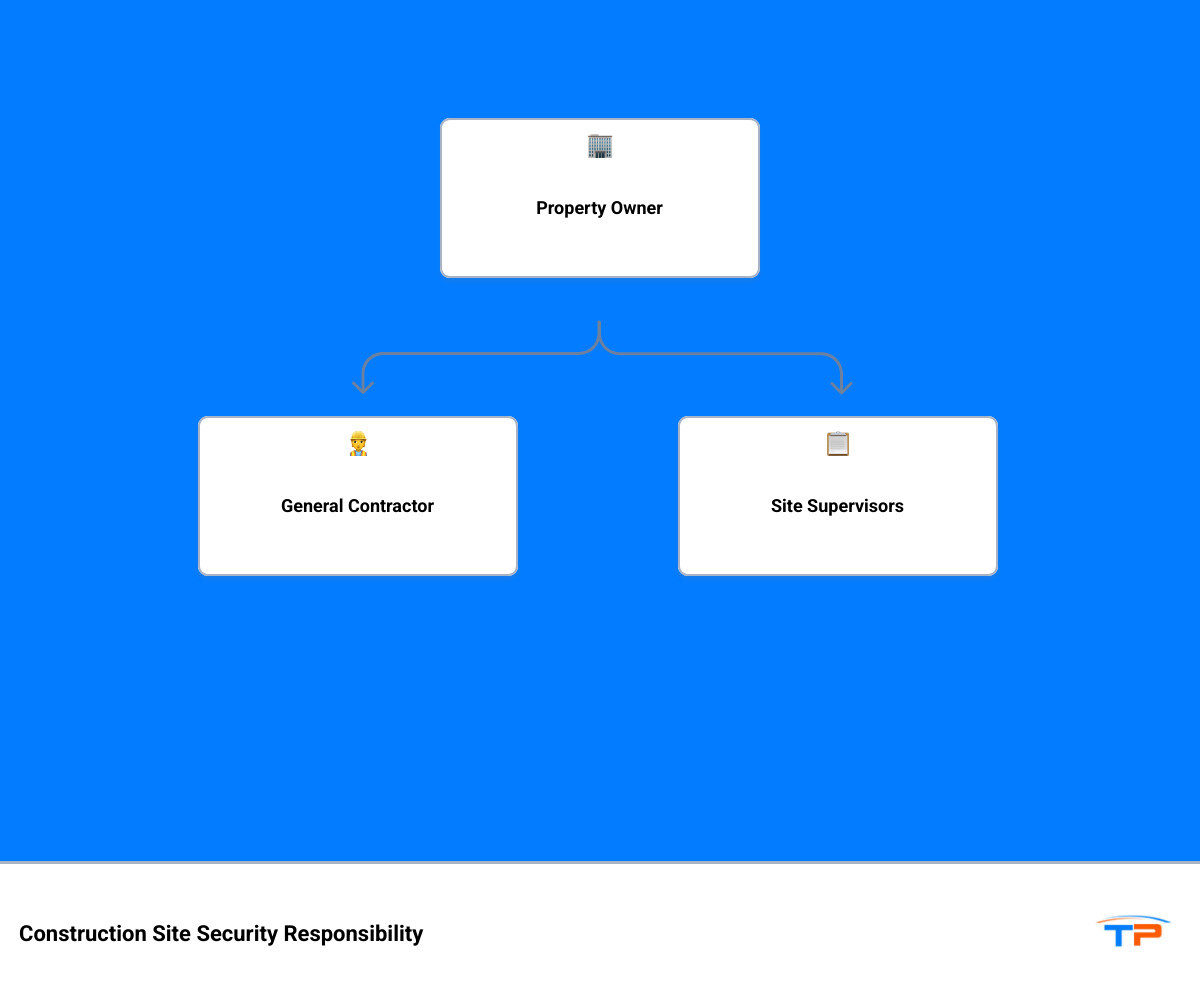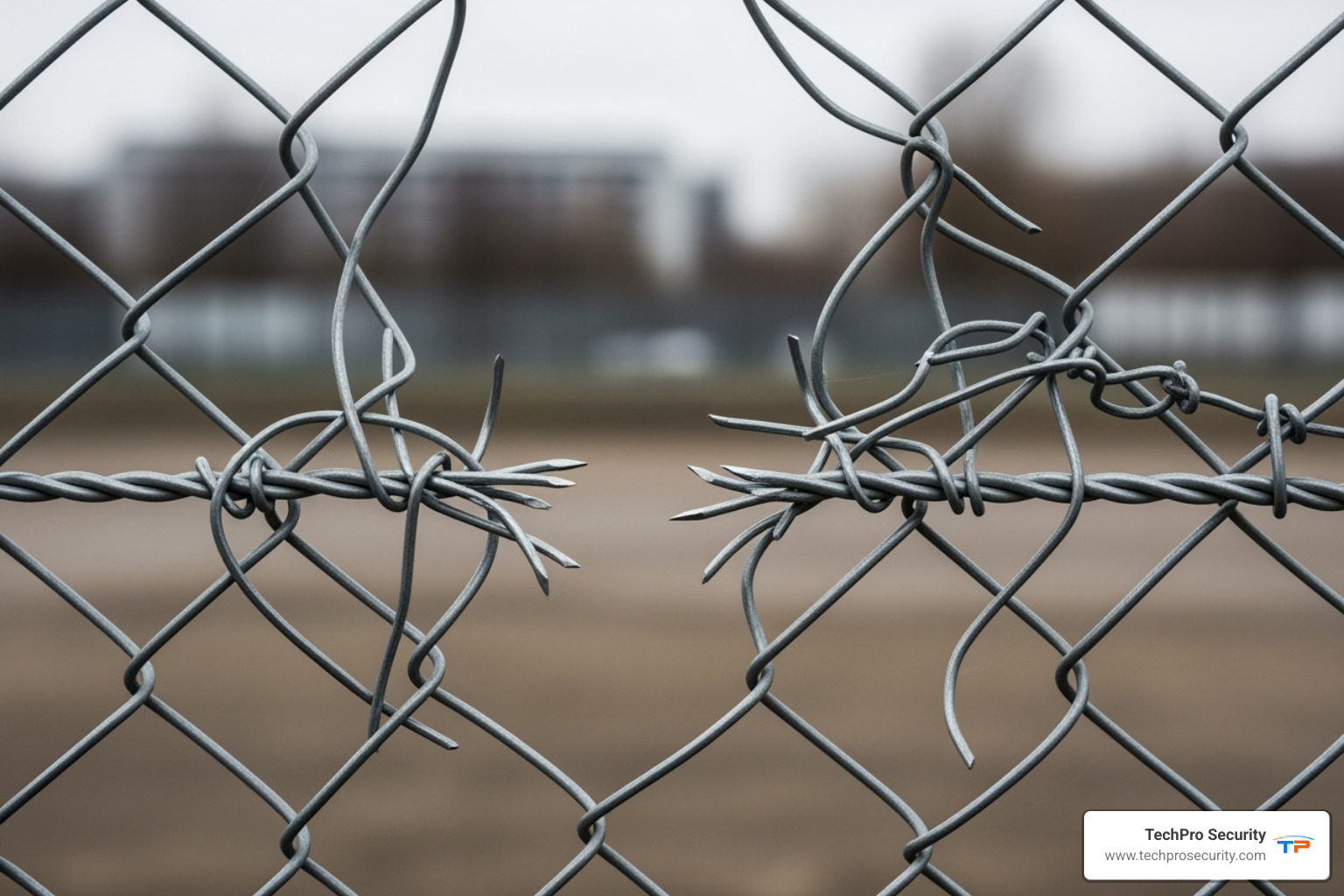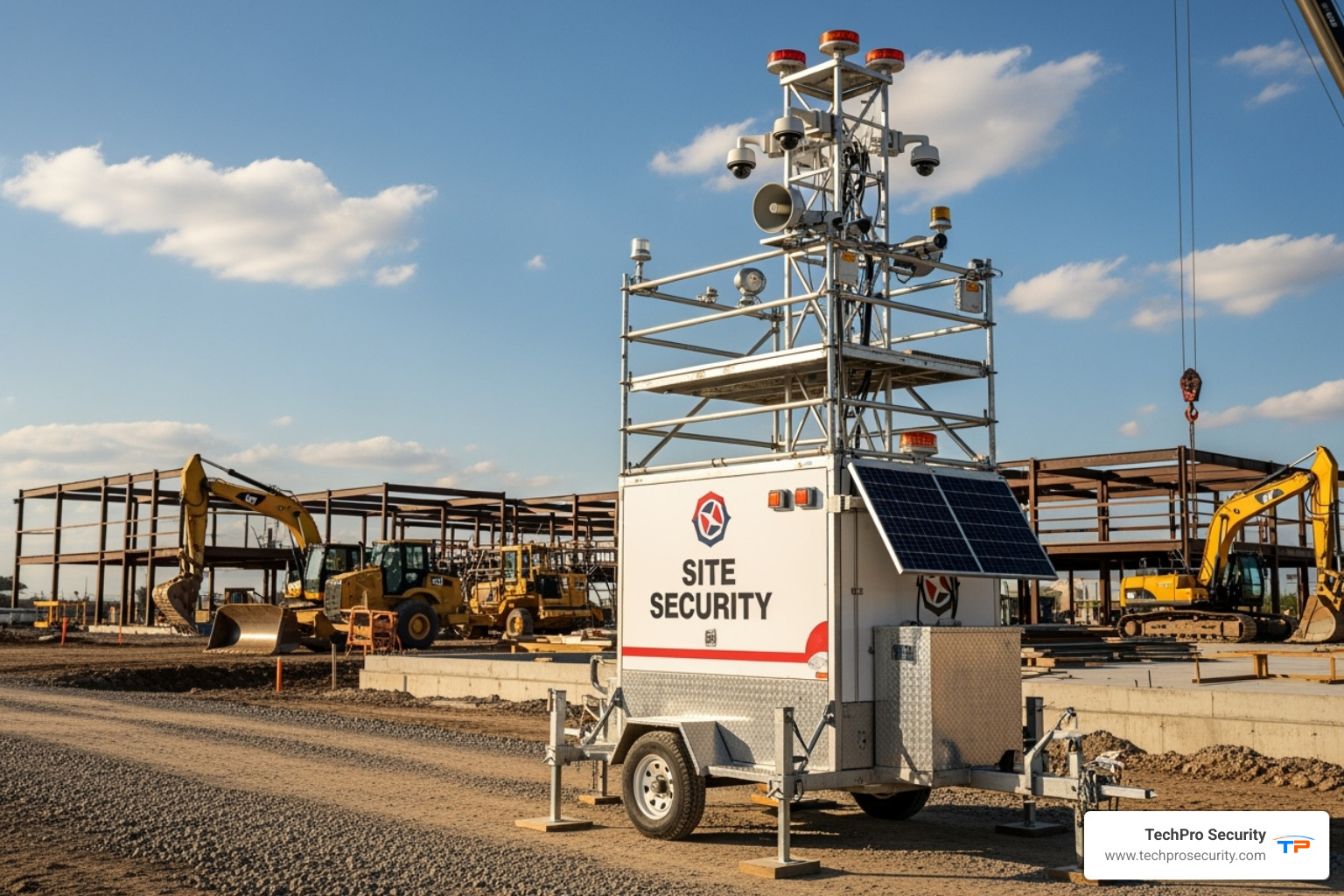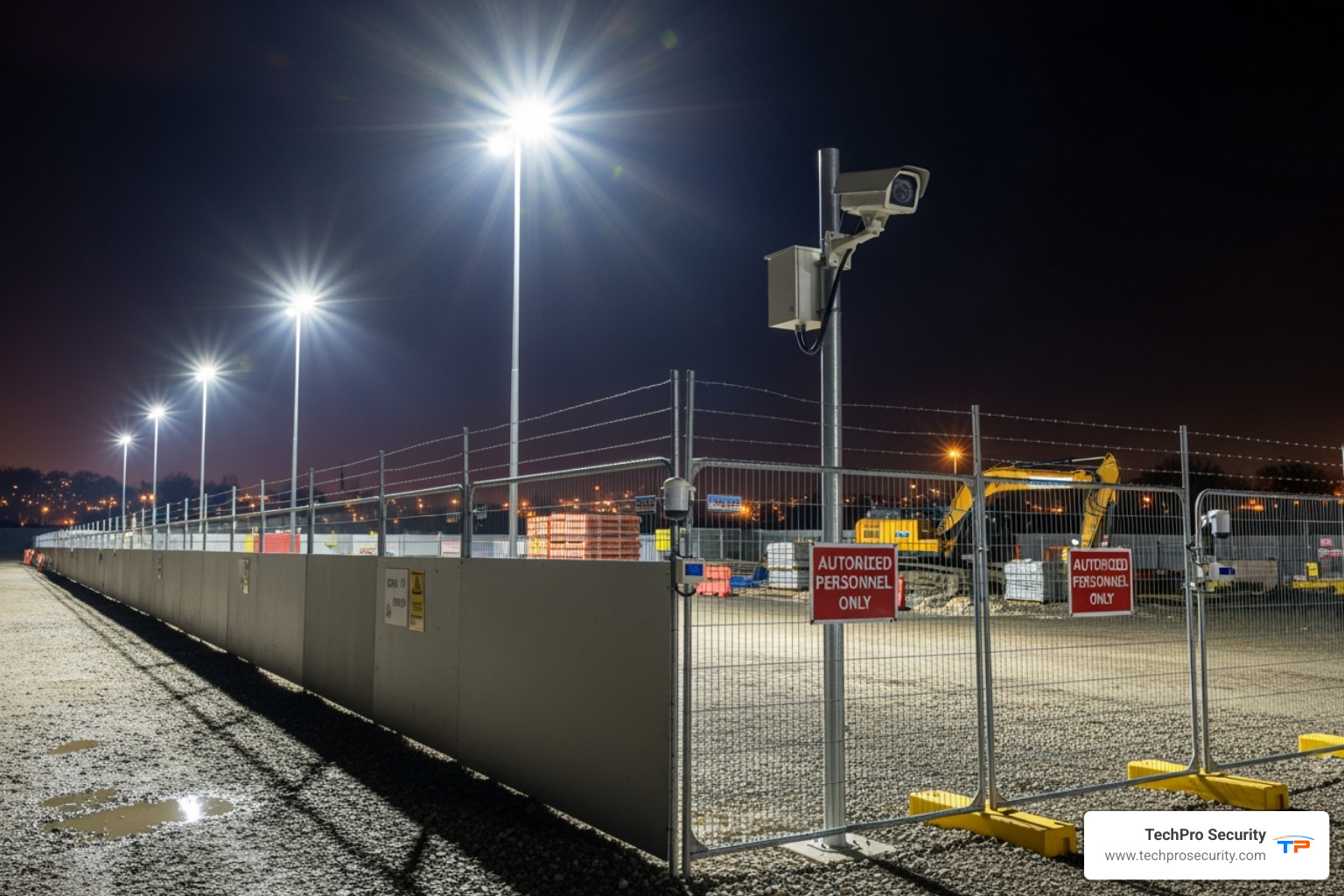Who is responsible for construction site security: Top 3
Why Construction Site Security Responsibility Matters More Than Ever
The question of who is responsible for construction site security affects everyone on a project. The answer isn’t simple; it’s a shared responsibility among several parties:
Primary Responsibility Holders:
- General Contractor – Overall site control and security planning
- Site Supervisors – Daily security management and protocol enforcement
- Subcontractors – Securing their crews, tools, and work areas
- Individual Workers – Personal accountability and reporting suspicious activity
- Property Owner – Legal compliance and insurance requirements
Construction sites face daily security threats. Theft alone costs the construction industry an estimated $1 billion annually, with criminals targeting everything from copper wire to heavy equipment. Beyond financial losses, poor security endangers workers and can halt projects for weeks.
The stakes are high. Construction sites are ideal targets: filled with valuable materials, often isolated, and with changing access points. When security fails, the costs go far beyond stolen tools, leading to project delays, insurance claims, and potential lawsuits.
As Brad Besner, founder of TechPro Security Products, I’ve spent over 15 years helping construction companies understand who is responsible for construction site security and implement effective protection. My team has designed custom perimeter systems that have prevented hundreds of break-ins, helping contractors avoid costly breaches.

Learn more about who is responsible for construction site security:
- construction site security
- how to secure a construction site
- why do i need construction site security
The High Cost of Insecurity: Common Threats to Construction Sites

Imagine arriving at your site to find a hole in the fence and your copper wiring gone. This happens thousands of times a year. Understanding these threats helps clarify who is responsible for construction site security, as everyone involved must know what they’re protecting against.
Theft hits construction sites hard. Companies lose an estimated $1 billion annually to theft alone. Criminals know sites are often easy targets.
Copper theft is a major problem, as it’s valuable and easy to transport. Lumber theft has also skyrocketed with rising material costs.
Then there’s equipment theft, a true budget killer. Disappearing machinery, tools, and generators leave projects at a standstill. Compounding the issue, law enforcement recovers less than 25% of stolen construction equipment.
Vandalism and property damage costs add up quickly. Graffiti, damaged materials, or arson can shut down projects for weeks. I’ve seen contractors lose months of work to vandals destroying freshly poured concrete.
Unauthorized site access creates major liability headaches. Sites are dangerous, with heavy machinery, open excavations, and hazardous materials. If a trespasser gets hurt, you can be sued. The “attractive nuisance” doctrine means property owners can be held responsible even for illegal entry.
Trespassing dangers are about human lives, not just liability. People die annually from accidents on sites they shouldn’t be on. Children are especially vulnerable.
The ripple effects are significant. Project delays can trigger contract penalties. Financial losses compound with replacement costs, new security measures, and higher insurance premiums. Insurance claims lead to tough questions from insurers about your security.
The reality is that every stakeholder pays when security fails. Understanding who is responsible for construction site security is about protecting everyone’s investment and safety, not just legal liability.
Who is Responsible for Construction Site Security? A Layered Approach
When asked who is responsible for construction site security, the answer is that it’s never one person’s job. It’s a layered approach, like building a house, where each layer provides protection.
Legally, it’s complex, involving contracts, local laws, and the “constructor” role—the entity with final say on project safety and security. However, everyone from the general contractor to the newest worker plays a part. It’s like a neighborhood watch; one person may coordinate, but it only works if everyone participates and follows the rules.
For a deeper dive into how all these pieces fit together, check out our guide on how to secure a construction site.
The General Contractor: The Primary Responsibility Holder
The general contractor is at the top of the security pyramid. They have overall site control and are typically the legal “constructor,” making them the first point of contact when things go wrong. Their job begins before construction starts. They must establish security protocols by assessing the site and creating a comprehensive strategy that covers everything from parking to visitor access.
Most general contractors partner with security technology providers like us at TechPro Security. They are building experts, while we are security experts. We help them design effective and budget-friendly camera, fencing, and monitoring systems. The general contractor is ultimately responsible for ensuring compliance with all security measures and faces the greatest liability for theft and accidents. Smart general contractors know that creating a comprehensive security plan from day one protects their business, reputation, and everyone on site.
Site Supervisors and Subcontractors: The On-the-Ground Leaders
Site supervisors and subcontractors implement the security plan daily. They are the on-the-ground leaders ensuring everyone follows the rules. Site supervisors handle daily security management, checking locks, securing tools, and monitoring for unauthorized personnel. Enforcing protocols means correcting security lapses, like unsecured equipment or propped-open gates.
Subcontractors are responsible for securing their own tools and equipment. Smart ones use secure storage, tracking systems, and ensure their crews understand that security is mandatory. Reporting incidents is crucial, as supervisors and subcontractors are often the first to spot suspicious activity. Training crews on security procedures during daily meetings is essential to reinforce the importance of security and foster a team effort.
Individual Workers and Temporary Staff: The First Line of Defense
Every person on a construction site, from veterans to temporary staff, plays a role in security. Personal accountability is key: locking up tools, securing valuables, and being mindful of surroundings. These simple actions create a more secure environment.
Workers are the first line of defense. Reporting suspicious activity—like unauthorized people or missing tools—is vital. A culture that encourages reporting without fear of reprisal is essential. Adhering to access control rules—using key cards, wearing ID badges, and respecting restricted areas—is non-negotiable. Fostering a security-conscious culture means everyone takes ownership.
For temporary workers, responsibility can be complex. The OSHA Temporary Worker Initiative offers guidance. Typically, the supervising company is responsible for daily safety and security training, while the staffing agency also has obligations to ensure workers are prepared. The bottom line: who is responsible for construction site security is about everyone working together to create a safe environment for on-time, on-budget project completion.
The Role of Technology in Modern Construction Site Security

A simple padlock and sign are no longer enough to protect a construction site. Modern technology has transformed security, helping to define who is responsible for construction site security by providing better tools for everyone involved.
Technology is a 24/7 security team. It works around the clock deterring criminal activity and collecting evidence. Remote monitoring capabilities allow you to watch your site from anywhere, at any time. The game-changer is AI-powered analytics. These smart systems differentiate between animals and intruders, learning site patterns to reduce false alarms and alert you to genuine threats. The power of modern security lies in integration. Cameras, access control, and monitoring services work together, creating a web of 24/7 protection.
Surveillance and Monitoring: Your Eyes on the Site
Old CCTV footage was often grainy and useless. Today’s CCTV systems deliver crystal-clear images, identifying faces, license plates, and text from a distance. Our Commercial Security Camera Installation services focus on strategic placement to cover entry points, material storage areas, and common blind spots.
Remote video monitoring means you’re always connected to your site. You can receive an alert on your phone, view live footage instantly, and decide whether to contact authorities or dismiss a false alarm. Real-time alerts are now incredibly smart. The system learns normal activity patterns and alerts you to anomalies, like someone climbing a fence at 2 AM. Criminals prefer darkness, but night vision and thermal cameras eliminate that advantage, seeing clearly in the dark and detecting heat signatures. When incidents occur, incident documentation from clear footage simplifies insurance claims and provides law enforcement with evidence for arrests.
Access Control: Securing the Perimeter and Key Areas
Access control systems determine who enters the site. They are like a tireless, vigilant bouncer at every entrance, keeping perfect records. Fencing and barriers are the first line of defense, funneling traffic to controlled entry points and establishing legal boundaries against trespassing.
Keycard and biometric entry systems are user-friendly and secure, eliminating the risks of lost keys and creating an automatic entry log. Visitor logging systems document all guests, issuing temporary credentials that can be automatically revoked. For vehicles, automatic gates offer secure and convenient entry. Protect valuable assets with secured high-value storage areas, which can use separate access credentials to ensure only trusted personnel can enter.
Our Access Control Systems are flexible and scale with your project. We can easily adjust permissions as the site evolves, giving each stakeholder the tools to protect their areas and helping to answer who is responsible for construction site security.
Best Practices for a Secure Construction Site

View construction site security as an investment, not an expense. A secure environment protects equipment, materials, worker safety, project success, and your company’s reputation. Data from The business case for safety and health from the U.S. Department of Labor shows that prioritizing safety and security reduces incidents. This leads to cost savings from fewer claims, reduced delays, and better productivity. Good intentions aren’t enough; security requires a systematic approach with clear protocols, defined responsibilities, and teamwork.
Establishing Clear Roles and Communication
Security failures often happen from unclear responsibilities. When there’s confusion about who is responsible for construction site security, security gaps appear.
- Clear contracts are your foundation. Every agreement needs specific security language outlining who secures equipment, reports incidents, and follows site-wide protocols.
- A clear chain of command is vital. Everyone on site must know who to contact for security concerns. This ensures incidents are handled quickly.
- Regular security briefings are essential. Use daily toolbox talks for security updates, incident reviews, and protocol reminders. This reinforces that security is everyone’s responsibility.
- Good signage works 24/7. Signs marking restricted areas, explaining procedures, and listing contacts guide personnel and deter trespassers.
Implementing a Comprehensive Security Plan
A solid security plan anticipates problems, acting as a blueprint for handling challenges.
- Perimeter security is your first defense. Use strong, tall fencing that resists cutting. Gates need heavy-duty locks, and the entire perimeter should be checked regularly for weak spots.
- Lighting is a powerful deterrent. Well-lit sites are less attractive to criminals. Focus lighting on entry points and storage areas. Motion-activated lights are effective for startling intruders and saving energy.
- Secure valuable assets. Lock up expensive equipment and materials when not in use. Use storage containers, chains, and GPS tracking on high-value machinery.
- Manage your inventory. Keep detailed records of tools and equipment, including serial numbers and photos. This aids in recovery and simplifies insurance claims.
- Establish clear emergency procedures. Everyone must know what to do during an incident: who to call, how to secure the scene, and what to document.
- Ensure regulatory compliance. Security measures must align with OSHA regulations and other legal requirements. OSHA’s safety guidelines often improve overall site security.
Frequently Asked Questions about Construction Site Security
Who is legally liable if someone gets hurt trespassing on a construction site?
This is a major concern for general contractors. The answer varies by state law but often involves the “attractive nuisance” doctrine. While property owners usually have minimal duty to trespassers, construction sites are different. They are filled with dangerous attractions—heavy machinery, cranes, and unfinished structures—that can seem irresistible, especially to children.
Courts often deem construction sites attractive nuisances. This means you could be liable for a trespasser’s injury if you didn’t take reasonable steps to secure the site, which falls under the legal concept of negligence. That’s why robust fencing and clear warning signage are legal necessities. They demonstrate you took reasonable precautions, which is crucial if who is responsible for construction site security becomes a legal question.
Who pays for tools stolen from a construction site?
This gets complicated and depends on contracts and who owned the tools. With the industry losing an estimated $1 billion annually to theft, understanding financial exposure is critical.
- Individual workers are usually responsible for their own tools. Personal insurance may offer limited coverage, often with high deductibles.
- Subcontractors need their own insurance (commercial property or inland marine) for their tools and equipment. General contractors should verify this coverage before work begins.
- The general contractor’s insurance (builder’s risk or general liability) usually covers materials and equipment owned by the GC or project owner. It typically excludes subcontractor or worker tools unless specified in the contract.
The reality is that less than a quarter of stolen construction equipment is ever recovered. Filing police reports is essential for insurance, but prevention is better. Clear contracts defining responsibility are key when who is responsible for construction site security becomes a financial question.
What is the first step to improving security on an active job site?
To improve site security, the first step isn’t buying equipment; it’s conducting a thorough risk assessment. You can’t protect against risks you don’t understand.
Identifying vulnerabilities is like a diagnosis. Walk the site looking for fencing gaps, unsecured gates, visible valuables, and dark areas that could conceal thieves. Review your current security measures to see if they are working effectively. Analyze past incidents on this or similar sites, as patterns in timing and targets can help you anticipate threats.
Consulting with security professionals is invaluable. At TechPro Security, our experience across South Florida helps us spot non-obvious vulnerabilities and recommend effective, modern solutions. Finally, prioritize high-risk areas based on your assessment. Focus your resources on protecting expensive equipment, sensitive materials, and easy access points for the biggest impact.
Conclusion
Understanding who is responsible for construction site security is more than a compliance checkbox; it’s the foundation for project success, preventing you from becoming another statistic in the industry’s $1 billion annual theft problem.
The reality is simple: shared responsibility is key. Everyone, from the general contractor to the newest worker, contributes to site protection. When everyone takes ownership, theft and accidents decrease, and projects stay on track. The difference between proactive and reactive security is critical. A reactive approach is too late. Smart contractors invest in security upfront, knowing prevention is far cheaper than the costs of theft and delays.
General contractors establish protocols, subcontractors and supervisors implement them daily, and individual workers act as the eyes and ears on the ground. Leveraging technology creates multiple, seamless layers of security. AI-powered surveillance, access control, strategic lighting, and remote monitoring work together to create an environment that deters criminals.
Creating a culture of security means everyone feels responsible. This is achieved through regular toolbox talks, clear signage, and open communication that encourages workers to report anything unusual. Here in South Florida, our 15+ years of experience have shown us how the right security approach transforms construction sites. We know every project has unique challenges requiring custom solutions.
Ready to build that culture of security on your next project? For a comprehensive site assessment and custom security solutions, explore our Commercial Security Camera Installation services. Let’s work together to keep your project safe, your workers protected, and your budget intact.

